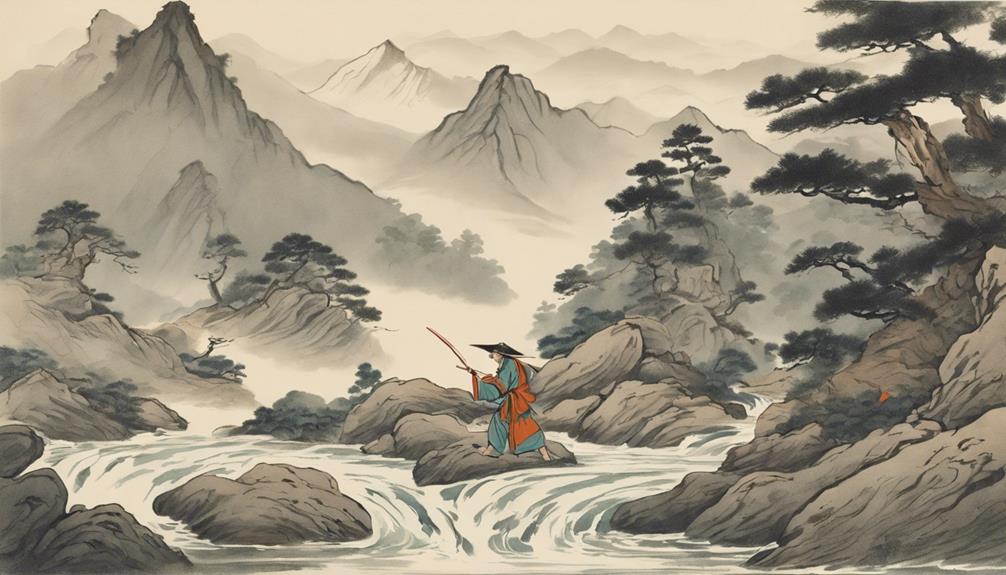Like a river effortlessly carving its path through the landscape, Taoism seamlessly blends with martial arts philosophy, encouraging you to explore how living in harmony with nature and oneself enhances your martial arts practice.
This ancient philosophy, with its deep-rooted principles of balance, flexibility, and flow, mirrors the physical and mental discipline required in martial arts. It’s no wonder the Yin and Yang symbol has become synonymous with martial arts schools worldwide.
But how exactly do Taoist concepts like Qi flow and the importance of soft over hard techniques shape the modern martial artist?
Contents
Historical Connections

The historical roots of martial arts philosophy deeply intertwine with Taoism’s principles, shaping the evolution of martial techniques through its emphasis on harmony and balance.
You’ll find that Taoist monks at the Shaolin Temple were pivotal in integrating these Taoist beliefs of harmony with nature into their martial practices. This not only influenced the physical aspects but also the mental and spiritual dimensions of martial arts.
The concept of Qi, or internal energy, plays a crucial role, with Taoism providing a profound foundation for martial artists to enhance their abilities by fostering balance and flow.
The philosophy underscores the importance of soft techniques and inner strength, steering practitioners towards a path where mind, body, and spirit aren’t seen as separate entities but as interconnected aspects of a whole, harmoniously aligned with the natural world.
Principles of Balance
Taoism’s emphasis on the equilibrium between Yin and Yang energies significantly shapes a martial artist’s journey toward achieving harmony in both technique and mindset. This balance is not merely a philosophical ideal but a practical guide.
It helps you harmonize your physical movements with your mental focus, enhancing your effectiveness in martial arts. Training under Taoist principles, you’re taught to find equilibrium in your techniques and overall approach.
| Yin (Receptive) | Yang (Active) |
|---|---|
| Inner calm | Dynamic movement |
| Adaptability | Strength |
| Fluidity | Precision |
Understanding and implementing these principles of balance fosters adaptability and fluidity, crucial for responding to dynamic situations effectively. This Taoist-inspired balance elevates martial arts beyond mere physical combat to a disciplined art form rooted in deep philosophical traditions.
Fluid Combat Techniques

Building on the principles of balance, fluid combat techniques in Taoist-influenced martial arts enable you to adapt and respond with ease in combat situations. Taoism’s emphasis on soft techniques against harsh force enhances your efficiency in overcoming opponents.
This philosophy leverages the concept of Wu Wei, advocating for effortless action by utilizing an adversary’s momentum to your advantage.
Mastery in these arts involves focusing on circular movements and flowing transitions, which are pivotal in maintaining harmony and balance during combat. By integrating Taoist principles, you learn to meld strength with gentleness.
This approach not only offers a strategic edge in physical engagements but also aligns with the overarching goal of achieving balance and harmony, hallmark traits of Taoist philosophy in martial arts.
Mental and Spiritual Growth

Martial arts, under the influence of Taoist philosophy, prioritize mental clarity and spiritual growth through dedicated practices like meditation and Qi cultivation. You’re guided to develop a strong mind-body connection, enhancing performance and self-awareness. Taoism’s principles foster mindfulness, resilience, and self-discipline, vital for your mental and spiritual journey.
| Key Aspect | Description | Benefit |
|---|---|---|
| Mind-Body Connection | Enhances performance through self-awareness | Improved self-awareness |
| Mindfulness | Promotes presence and concentration | Increased mental clarity |
| Qi Cultivation | Harnessing inner energy for focus and balance | Emotional balance & spiritual growth |
This structured approach encourages you to cultivate patience, humility, and compassion, achieving inner peace and resilience for holistic growth.
Taoism in Modern Practice
In contemporary martial arts practice, Taoist principles are frequently integrated to deepen mental focus and spiritual awareness. This modern practice leverages Taoism’s foundational concepts, such as harmony, balance, and the natural flow of energy, to enhance both physical and mental training.
By embracing the duality and interconnectivity of Yin and Yang, martial artists achieve a holistic approach to their discipline, ensuring that their physical prowess is matched by inner strength and mindfulness.
Moreover, the integration of Taoist practices promotes a heightened level of self-awareness and spiritual depth. This philosophical underpinning not only enriches the martial artist’s skill set but also fosters a deeper connection to the essence of martial arts.
Through Taoism, practitioners in the modern era find a path to balance and energy flow that elevates their discipline beyond mere physicality.
Conclusion
In conclusion, Taoism significantly shapes martial arts philosophy through its historical roots and principles that emphasize balance, harmony, and the interplay of opposing forces.
By integrating Taoist concepts such as Yin and Yang, breath control, and Qi flow, martial arts not only enhance physical prowess but also foster mental and spiritual growth.
These practices encourage a holistic approach to combat and self-improvement, reflecting Taoism’s deep impact on the martial arts ethos even in contemporary practice.





